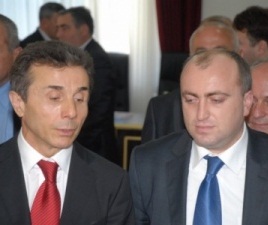
New Rhetoric, but Old Policy on Adjara Autonomy
Publication: Eurasia Daily Monitor Volume: 9 Issue: 215
By:

On October 28, Georgia’s new Prime Minister Bidzina Ivanishvili named the new Head of the Government of the Autonomous Republic of Adjara (hereafter, Adjara)—a 1,120 square mile large region of stunningly beautiful mountains and rain forests, with the population of approximately 376,000, located on the eastern coast of the Black Sea in southwestern Georgia. On the same occasion, Ivanishvili vowed to expand the powers and rights of Adjara and its government. He also talked about the need for developing local governance and promoting decentralization in Adjara and in other regions of Georgia (www.civil.ge; www.interpressnews, October 28).
As far as Adjara, the new Georgian government’s policy towards the region is not any different from that of any previous Georgian government in the last 20 years—Ivanishvili signaled that the question of Adjara and its future remains the reclusive business of narrow political elites in Georgia. In other words, the government will still avoid asking the region’s population, via popular referendum: what kind of autonomy they would like to have, such as how the powers and responsibilities should be distributed between the Adjara and the central government for example Or whether the local population wants to keep the autonomy at all against dramatically changed demographics and political circumstances in the region?
The position of Georgia’s political elites towards Adjara largely was determined by the political discourse-narrative that Moscow created and worked hard to impose on all sides to ensure Georgia’s political and territorial fragmentation. This narrative stated: Adjara contains the potential for religious/ethnic separatist conflict, similar to those in other two Georgian breakaway autonomous regions—Abkhazia and South Ossetia. Therefore, if Georgia wants to avoid analogous violent conflict in Adjara and even lure back the two breakaway regions, Tbilisi has to maintain and even expand Adjara’s autonomy. Georgian elites, as well as Georgia’s friends in the West, uncritically adopted the Kremlin narrative. Subsequently, successive Georgian governments and political elites, tried hard to prove to Moscow and to the breakaway regions, as well as to Georgia’s friends in the West that Tbilisi, no matter what, intended to keep the autonomy and even expand it. Ivanishvili’s recent statement is a mere continuation of the same old policy, built on the Kremlin narrative.
In fact, the question of Adjara is fundamentally different from that of Abkhazia and/or South Ossetia. Adjara was established as a result of 1921 Kars Treaty, signed between Soviet Russia and Turkey. In exchange for ceding Adjara, which had been under the Ottoman rule for two and a half centuries, Turkey demanded autonomy to be given to local Sunni Muslims (ethnic Georgians), which comprised an overwhelming majority of the region’s population. The Russian-installed Bolshevik government of occupied Georgia also signed the treaty. Soviet Russia established Adjara as a Soviet Socialist Republic in 1921 within Soviet Georgia.
When Georgia regained its independence in 1991, newly elected president Zviad Gamsakhurdia appointed Aslan Abashidze, a representative of local elites, as the Chairman of the Supreme Council of Autonomous Republic of Adjara, thus the ruler of the region.
Abashidze quickly turned Adjara into his fiefdom, ruling it with an iron fist for the next 12 years. Relying on Moscow’s political support, doubled with Russian 12th Military Base in Batumi and his private militia, he consolidated his powers, established authoritarian rule and dealt with his opponents with repression and violence. He isolated the region from the rest of Georgia, defied the weak central government led by Eduard Shevardnadze since 1992 and evaded paying taxes to the central budget. Abashidze amassed huge personal wealth by organized crime and corruption, impoverishing the region’s population. Shevardnadze largely ignored the Adjara question and at times even allied with Abashidze, who quite actively participated in Georgia’s political life, mostly via his political party commonly known as Revival (Rustavi 2, Imedi TV, November 7, 10, 11, 12, 2003).
There were frequent speculations, often skillfully exacerbated by Abashidze himself, about the threat of succession of Adjara. However, the standoff between Adjara and the central government never turned into religious/ethnic separatist conflict. Such a conflict was hardly feasible since 93.2 percent of the region’s population was ethnically Georgian, having Georgian as native language (www.geostat.ge, Census, 2002). Also, as a result of the process of voluntary re-Christianization since Georgia’s independence, the number of Orthodox Christians in Adjara increased to 63 percent of the local population, while that of Muslims declined to 30 percent, mainly remaining in the remote, mountainous Khulo District (Department of Statistics of the Autonomous Republic of Adjara, 2006).
On May 6, 2004, a little over five months after Georgia’s Rose Revolution, Abashidze was overthrown as a result of mass public protests in Adjara and concentrated pressure from President Mikheil Saakashvili’s central government. Abashidze fled to Russia (www.regnum.ru, May 5, 6, 2004).
Saakashvili reestablished the central government’s rule over Adjara. However, his government and the Georgian Parliament rejected the calls to hold a plebiscite in the region over Adjara’s autonomous status. According to the adopted constitutional law, the President acquired the right to propose candidacy for the Head of the Government of Adjara, and to disband the 30 member legislature-Supreme Council, as well as the entire government. The Georgian Parliament acquired the right to suspend legislative acts adopted by the Supreme Council. Adjara retained the right to manage its finances. The opposition criticized the government for imposing direct presidential rule and downgrading the region’s autonomy (www.civil.ge, May 7, 29, June 25, 27, 2004). However, the new Georgian government of Bidzina Ivanishvili has vowed to undo the actions of the previous government and increase Adjara’s autonomy. No matter how the government proceeds to do so, the trend remains the same: the decision making process over the future of the autonomy remains in the domain of Georgia’s narrow political elites.
Successive Georgian governments and elites from 1991 to the present have monopolized the decision making process regarding the fate of Adjara. Seclusion of the decision making process to narrow elites has not worked well either for the region or for the rest of Georgia. The new government will now need to find a way to change that trend.




